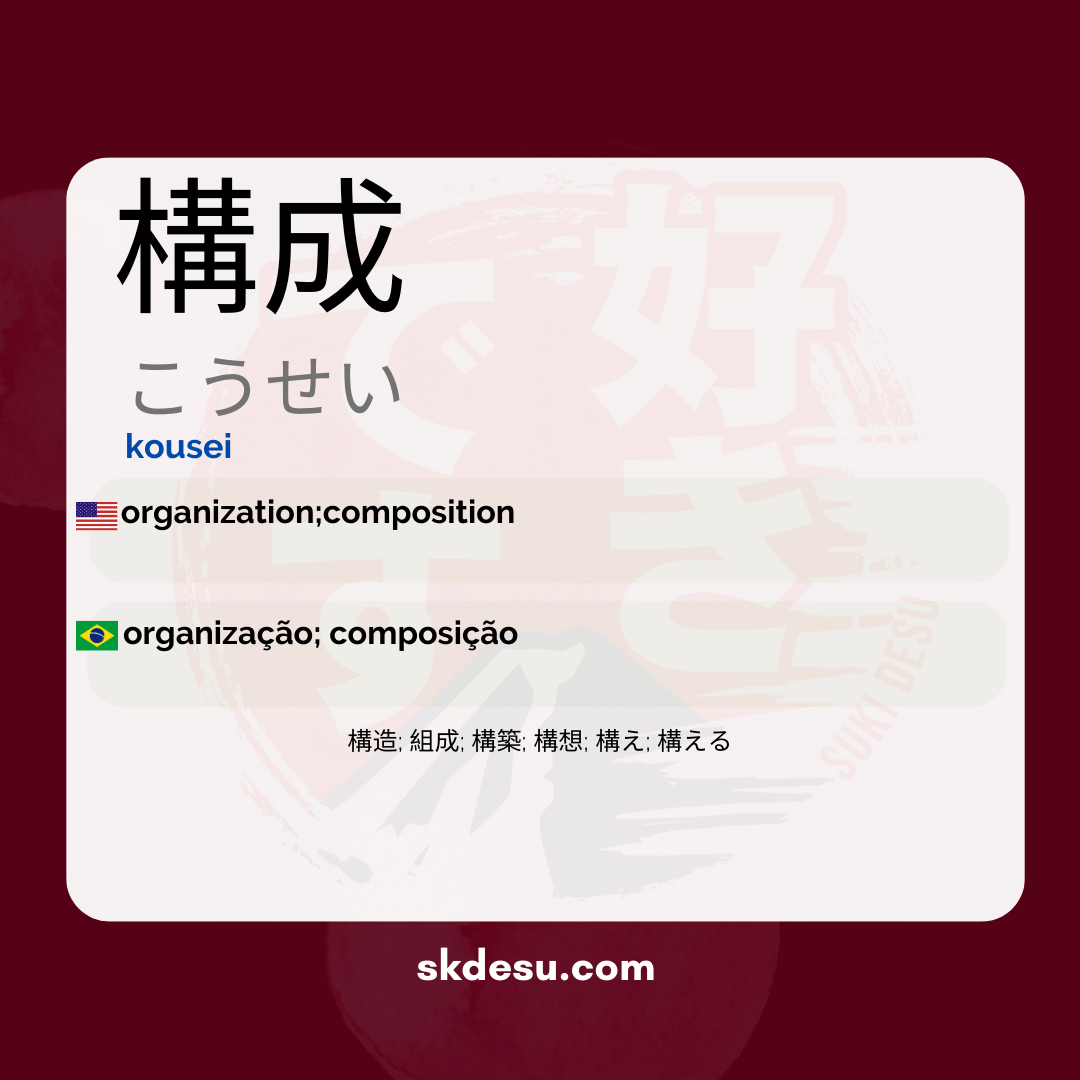Translation and Meaning of: 構成 - kousei
On this page, we will study the meaning of the Japanese word 構成 (kousei) and its translation into English. Let's see their different meanings, example phrases, explanations, etymology and the similar words.
Romaji: kousei
Kana: こうせい
Type: noun
L: jlpt-n3
Translation / Meaning: organization; composition
Meaning in English: organization;composition
Definition: Combine various elements or pieces.
Sumário
- Etymology
- Vocabulary
- Writing
- Phrases
Explanation and Etymology - (構成) kousei
The term 「構成」 (kousei) is a Japanese word that can be translated as "structure," "composition," or "formation." This expression has two main parts. The first kanji, 「構」 (kou), means "to build," "to organize," or "to assemble," while the second kanji, 「成」 (sei), carries the meaning of "to become," "to form," or "to complete." The combination of these two characters results in the idea of creating or organizing something in a coherent form.
Etymologically, 「構」 is composed of the radical 「木」, which means "tree," suggesting the idea of building or structuring from basic materials. On the other hand, 「成」 is a kanji that suggests the conclusion or establishment of something, reflecting the process of finalizing that structure. When combined, these kanjis convey the notion of building and completing, which can refer to a variety of situations, from the structure of a story to the composition of a group or system.
The word「構成」is widely used in Japanese to describe the composition of something, whether it is a work of art, a team, or a system. Its applicability can be seen in academic contexts, engineering, art, and many other fields. In the literary world, for example, an author may talk about the "構成" of a novel to discuss its plot and organization. This demonstrates the versatility and importance of this expression in effective communication in the Japanese language.
Synonyms and similar words
- 構造 (Kōzō) - Structure, arrangement of elements within a system.
- 組成 (Kごせい) - Composition, the way in which parts are assembled or formed.
- 構築 (Kōchiku) - Construction, the act of building or establishing something.
- 構想 (Kōsō) - Conception, initial idea or planning of something.
- 構え (Kamae) - Posture, attitude, or willingness to act.
- 構える (Kamaeru) - Prepare yourself, to be in a position of expectation or readiness.
Words related
Words with the same pronunciation: こうせい kousei
How to Write in Japanese - (構成) kousei
See below a step-by-step guide on how to write the word by hand in Japanese (構成) kousei:
Example Sentences - (構成) kousei
Below are some example sentences:
Bushu wa kanji no kōsei yōso o hyō shimasu
Bushu represents the structural elements of kanji.
The radical represents the components of Kanji.
- 部首 - means "radical" in Japanese and is used to classify kanji (Japanese ideograms) according to their features and components.
- は - topic marking particle, which indicates that what comes next is the subject of the sentence.
- 漢字 - means "Chinese characters" and refers to the ideograms that were imported from China and adapted into the Japanese language.
- の - possession particle, which indicates that what follows is the possessor or constituent of the object.
- 構成要素 - means "constituent elements" and refers to the strokes and components that make up kanji.
- を - direct object particle, which indicates that what follows is the direct object of the sentence.
- 表します - means "represents" and is the verb that indicates the action that the radicals perform when composing the kanji.
Kono webusaito no kōsei wa hijō ni shinpuru desu
The structure of this website is very simple.
Setting up this site is very simple.
- この - demonstrative pronoun meaning "this" or "this one"
- ウェブサイト - compound word that means "website"
- の - particle that indicates possession or belonging
- 構成 - noun meaning "composition" or "structure"
- は - particle that indicates the topic of the sentence
- 非常に - adverb meaning "very" or "extremely"
- シンプル - adjective meaning "simple"
- です - verb "to be" in the present tense
Bunshi wa kagakuteki na kōseiyōso desu
Molecule is a fundamental chemical component.
Molecules are chemical components.
- 分子 - "molecule" in Japanese.
- は - is a grammatical particle that indicates the topic of the sentence.
- 化学的な - It means "químico" in Japanese.
- 構成要素 - "componente" means "コンポーネント" in Japanese.
- です - It is a grammatical particle that indicates the end of the sentence and formality.
Other words of the same type: noun
See other words from our dictionary that are also: noun

